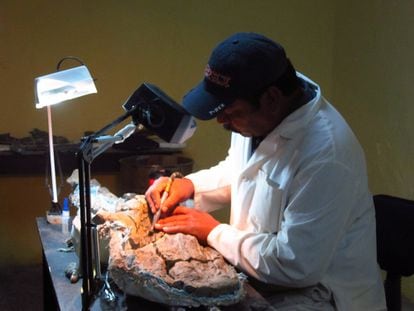Illustration of 'Tlatolophus galorum' .INAH
He ate plants, was quite communicative, and lived in what is now northern Mexico more than 72 million years ago.
This was the new species of dinosaur discovered this week by a team of paleontologists from the National Autonomous University of Mexico and the National Institute of Anthropology and History after eight years of research.
It is the
Tlatolophus galorum
, a specimen with a large crest 1.3 meters long that was found in General Cepeda, a community of less than 5,000 inhabitants in the State of Coahuila.
More information
The eagle shark that sailed the waters of the Gulf of Mexico 93 million years ago
Pleistocene mammoths at a Mexican airport
40 dinosaur footprints found in Mexico from 65 million years ago
The dinosaur was about 12 meters long from snout to tail and was between three and four meters high, explains Felisa Aguilar, a researcher at INAH. It was a robust animal and most of the time it walked on its two hind legs, although it leaned on its front legs to eat and rest. It is likely that it fed on plants similar to birds of paradise, gannets and old versions of bananas, although it is something that will need to be studied in greater detail.
Based
on
the findings that have already been made in Coahuila, Aguilar believes that the
Tlatolophus
lived in a very diverse area where it lived with other dinosaurs such as
Velafrons coahuilensis
, another type of hadrosaur that had a beak similar to that of a duck, and with the
Coahuilaceratops
magnahorn,
a ceratopsid named for its large horns. "It was an unforgettable experience, especially for completing all the work that was done," says the researcher in an interview.
The scientific name is a combination of the Nahuatl term for word,
tlahtolli
, and the Greek word for crest,
lophus
. The researchers chose it because the shape of the crest resembles a virgula, the symbol that Mesoamerican peoples used to represent speech or communication in the codices. This dinosaur had a series of passages that connected the windpipe, nose and crest and that functioned as a kind of trumpet that allowed it to communicate.
This peculiarity made him a talkative dinosaur.
"We know that they had ears with the ability to receive low-frequency sounds, so they must have been peaceful but talkative dinosaurs," Ángel Ramírez, one of the researchers, explained in a statement.
"Some paleontologists theorize that they made loud sounds to scare off carnivores or for breeding purposes, suggesting that the ridges sported bright colors," added Ramírez.
The researcher José López Espinoza cleans one of the skeletal remains in December 2013.INAH
The journey to track down the
Tlatolophus
began in 2013, when its tail was found. Paleontologists unearthed more than 34 bone fragments one by one: from the femur to the neurocranium, where the brain was located. The key to the discovery is in the skull, which was 80% preserved. This made it possible to compare it with other fossils found in that region and to realize that it was a species that was not known before.
The shape of the nose, crest, and head led the researchers to conclude that the dinosaur was a hadrosaur from the Parasaurophine tribe. Hadrosaurs are a family also known as “duck-billed” dinosaurs, which walked on two legs when they were young and four when they became adults. The Parasaurophins are one of the four tribes of that family, which also stands out for its crests. What is striking is that remains had previously been found in Utah, New Mexico and in the Canadian province of Alberta. They are relatively well known in popular culture because they have been depicted in the
Jurassic Park
saga
. The
Tlatolophus
It is, however, the first parasaurolofin found in Mexico.
"Hopefully we'll see him running in new movies soon," jokes Aguilar.
Image of the 'Tlatolophus galorum' skull.INAH
The world that this dinosaur inhabited looked very different from today.
70 million years ago, in the geological era of the Cretaceous, North America was split into two huge islands, bounded by the Rocky Mountains to the west and the Appalachian Mountains to the east.
In between was an immense inland sea that ran from the present territory of Canada to the Gulf of Mexico.
Coahuila, now a predominantly desert area, had a tropical climate and was a coastal plain.
One part of the State was submerged under water and another was attached to the mainland, forming what is known as the Paleopeninsula of Coahuila.
The hypothesis of the researchers is that the dinosaur died in an area with a lot of water and that it was later buried by the earth, which helped to preserve it. "This fossil is an exceptional case in Mexican paleontology," Aguilar points out because skulls are usually found in fragments and not in practically complete pieces. It is a rare finding because it is preserved in these conditions.
The results of the research were published in the specialized journal
Cretaceous Research
. This same year, another discovery of a new species from the Cretaceous was made known: the
Aquilolamna milarcae
, a shark with two huge temporary fins that crossed the ancient waters of northern Mexico 90 million years ago. That discovery took place in Vallecillo, in the state of Nuevo León, about 250 kilometers from General Cepeda. “We are privileged”, Aguilar comments on the quality of the deposits in the country, “it is an opportunity to travel to the past and each town tells us about different moments”. As scientists track the next discovery, the remains of the
Tlatolophus
They are exhibited in the municipal seat of the small community of Coahuila for the enjoyment of inhabitants, visitors and curious people.
Subscribe here
to the
newsletter
of EL PAÍS México and receive all the informative keys of the current situation of this country

